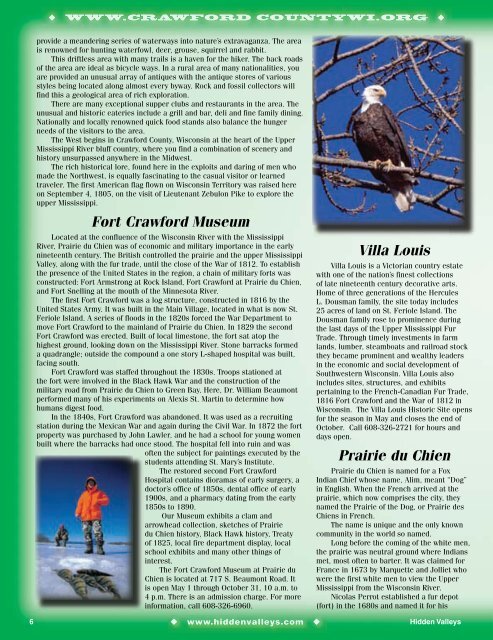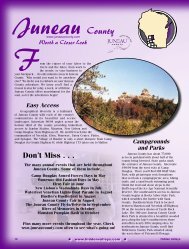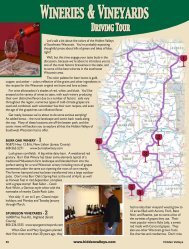Don't Miss - Hidden Valleys of Southwestern Wisconsin
Don't Miss - Hidden Valleys of Southwestern Wisconsin
Don't Miss - Hidden Valleys of Southwestern Wisconsin
Create successful ePaper yourself
Turn your PDF publications into a flip-book with our unique Google optimized e-Paper software.
u<br />
www.cRAwFORD cOuntywi.ORg u<br />
provide a meandering series <strong>of</strong> waterways into nature’s extravaganza. The area<br />
is renowned for hunting waterfowl, deer, grouse, squirrel and rabbit.<br />
This driftless area with many trails is a haven for the hiker. The back roads<br />
<strong>of</strong> the area are ideal as bicycle ways. In a rural area <strong>of</strong> many nationalities, you<br />
are provided an unusual array <strong>of</strong> antiques with the antique stores <strong>of</strong> various<br />
styles being located along almost every byway. Rock and fossil collectors will<br />
find this a geological area <strong>of</strong> rich exploration.<br />
There are many exceptional supper clubs and restaurants in the area. The<br />
unusual and historic eateries include a grill and bar, deli and fine family dining.<br />
Nationally and locally renowned quick food stands also balance the hunger<br />
needs <strong>of</strong> the visitors to the area.<br />
The West begins in Crawford County, <strong>Wisconsin</strong> at the heart <strong>of</strong> the Upper<br />
<strong>Miss</strong>issippi River bluff country, where you find a combination <strong>of</strong> scenery and<br />
history unsurpassed anywhere in the Midwest.<br />
The rich historical lore, found here in the exploits and daring <strong>of</strong> men who<br />
made the Northwest, is equally fascinating to the casual visitor or learned<br />
traveler. The first American flag flown on <strong>Wisconsin</strong> Territory was raised here<br />
on September 4, 1805, on the visit <strong>of</strong> Lieutenant Zebulon Pike to explore the<br />
upper <strong>Miss</strong>issippi.<br />
Fort Crawford Museum<br />
Located at the confluence <strong>of</strong> the <strong>Wisconsin</strong> River with the <strong>Miss</strong>issippi<br />
River, Prairie du Chien was <strong>of</strong> economic and military importance in the early<br />
nineteenth century. The British controlled the prairie and the upper <strong>Miss</strong>issippi<br />
Valley, along with the fur trade, until the close <strong>of</strong> the War <strong>of</strong> 1812. To establish<br />
the presence <strong>of</strong> the United States in the region, a chain <strong>of</strong> military forts was<br />
constructed: Fort Armstrong at Rock Island, Fort Crawford at Prairie du Chien,<br />
and Fort Snelling at the mouth <strong>of</strong> the Minnesota River.<br />
The first Fort Crawford was a log structure, constructed in 1816 by the<br />
United States Army. It was built in the Main Village, located in what is now St.<br />
Feriole Island. A series <strong>of</strong> floods in the 1820s forced the War Department to<br />
move Fort Crawford to the mainland <strong>of</strong> Prairie du Chien. In 1829 the second<br />
Fort Crawford was erected. Built <strong>of</strong> local limestone, the fort sat atop the<br />
highest ground, looking down on the <strong>Miss</strong>issippi River. Stone barracks formed<br />
a quadrangle; outside the compound a one story L-shaped hospital was built,<br />
facing south.<br />
Fort Crawford was staffed throughout the 1830s. Troops stationed at<br />
the fort were involved in the Black Hawk War and the construction <strong>of</strong> the<br />
military road from Prairie du Chien to Green Bay. Here, Dr. William Beaumont<br />
performed many <strong>of</strong> his experiments on Alexis St. Martin to determine how<br />
humans digest food.<br />
In the 1840s, Fort Crawford was abandoned. It was used as a recruiting<br />
station during the Mexican War and again during the Civil War. In 1872 the fort<br />
property was purchased by John Lawler, and he had a school for young women<br />
built where the barracks had once stood. The hospital fell into ruin and was<br />
<strong>of</strong>ten the subject for paintings executed by the<br />
students attending St. Mary’s Institute.<br />
The restored second Fort Crawford<br />
Hospital contains dioramas <strong>of</strong> early surgery, a<br />
doctor’s <strong>of</strong>fice <strong>of</strong> 1850s, dental <strong>of</strong>fice <strong>of</strong> early<br />
1900s, and a pharmacy dating from the early<br />
1850s to 1890.<br />
Our Museum exhibits a clam and<br />
arrowhead collection, sketches <strong>of</strong> Prairie<br />
du Chien history, Black Hawk history, Treaty<br />
<strong>of</strong> 1825, local fire department display, local<br />
school exhibits and many other things <strong>of</strong><br />
interest.<br />
The Fort Crawford Museum at Prairie du<br />
Chien is located at 717 S. Beaumont Road. It<br />
is open May 1 through October 31, 10 a.m. to<br />
4 p.m. There is an admission charge. For more<br />
information, call 608-326-6960.<br />
Villa Louis<br />
Villa Louis is a Victorian country estate<br />
with one <strong>of</strong> the nation’s finest collections<br />
<strong>of</strong> late nineteenth century decorative arts.<br />
Home <strong>of</strong> three generations <strong>of</strong> the Hercules<br />
L. Dousman family, the site today includes<br />
25 acres <strong>of</strong> land on St. Feriole Island. The<br />
Dousman family rose to prominence during<br />
the last days <strong>of</strong> the Upper <strong>Miss</strong>issippi Fur<br />
Trade. Through timely investments in farm<br />
lands, lumber, steamboats and railroad stock<br />
they became prominent and wealthy leaders<br />
in the economic and social development <strong>of</strong><br />
<strong>Southwestern</strong> <strong>Wisconsin</strong>. Villa Louis also<br />
includes sites, structures, and exhibits<br />
pertaining to the French-Canadian Fur Trade,<br />
1816 Fort Crawford and the War <strong>of</strong> 1812 in<br />
<strong>Wisconsin</strong>. The Villa Louis Historic Site opens<br />
for the season in May and closes the end <strong>of</strong><br />
October. Call 608-326-2721 for hours and<br />
days open.<br />
Prairie du Chien<br />
Prairie du Chien is named for a Fox<br />
Indian Chief whose name, Alim, meant “Dog”<br />
in English. When the French arrived at the<br />
prairie, which now comprises the city, they<br />
named the Prairie <strong>of</strong> the Dog, or Prairie des<br />
Chiens in French.<br />
The name is unique and the only known<br />
community in the world so named.<br />
Long before the coming <strong>of</strong> the white men,<br />
the prairie was neutral ground where Indians<br />
met, most <strong>of</strong>ten to barter. It was claimed for<br />
France in 1673 by Marquette and Jolliet who<br />
were the first white men to view the Upper<br />
<strong>Miss</strong>issippi from the <strong>Wisconsin</strong> River.<br />
Nicolas Perrot established a fur depot<br />
(fort) in the 1680s and named it for his<br />
<br />
u<br />
www.hiddenvalleys.com u<br />
<strong>Hidden</strong> <strong>Valleys</strong>







